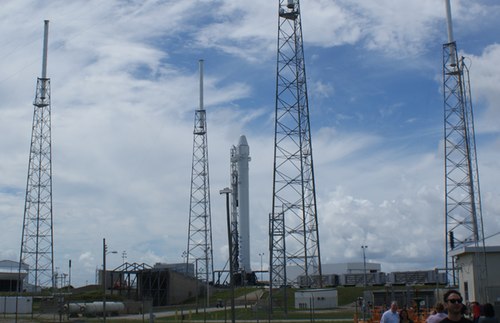
Falcon 9 and the CRS-1 Dragon spacecraft on the launch pad at Cape Canaveral about seven and a half hours before its scheduled launch Sunday. (credit: J. Foust)
SpaceX is less than five hours from launching the first of twelve cargo missions to the ISS—technology and weather permitting. SpaceX erected the Falcon 9 rocket, with its Dragon spacecraft on top, shortly before 1 pm Eastern time this afternoon. The rocket is slated to launch at 8:35 pm EDT tonight (0035 GMT Monday) in an instantaneous launch window, which means that any technical glitch or weather problem would scrub the launch for the night. There are no technical issues being reported, and forecasts call for a 60% chance of acceptable weather at launch time.
This mission is designated by NASA as CRS-1: the first Commercial Resupply Services flight by SpaceX to the International Space Station. The Dragon is carrying a relatively light load when measured by mass: about 400 kilograms of equipment and other supplies. NASA and SpaceX officials, though, said the volume of the Dragon is filled with experiments and other equipment for the station. Dragon will also bring back 760 kilograms of equipment from the station, including blood and urine samples collected during experiments on the station over more than a year. While the pverall mass is low, SpaceX president Gwynne Shotwell said at a press conference yesterday that they anticipate, over all 12 CRS flights, to transport 60 metric tons of cargo to and from the station (their contract with NASA calls for at least 20 metric tons to the station.)
Getting these flights started will be a milestone for commercial spaceflight, demonstrating its ability to do something that previously was done by space agencies only, and thus freeing up NASA to do cutting-edge exploration beyond LEO. It’s also important, though, the the utilization of the ISS itself: the long-term future of the ISS depends on the quantity and quality of the research being performed there, which requires regular access to transport experiments and other suppliers both to and from the station. Julie Robinson, the NASA ISS program scientist, said yesterday there are over 100 experiments active on the US segment of the ISS at any one time. The station, she said, is now a “dynamic and fully-established lab” and “it’s really full-bore, full speed ahead.”

Leave a Reply